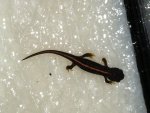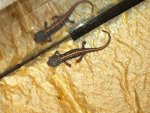jasper408
Member
- Joined
- Jul 16, 2012
- Messages
- 208
- Reaction score
- 8
- Points
- 18
- Country
- United States
- Display Name
- Jasper
I had been feeding a particular individual a staple of fruit flies cultured on Repashy Superfly, a fruit fly medium. I had completely forgotten that it contains a small percentage of Repashy SuperPig, but surprisingly, it seems to have for a particular C.e. popei individual that had been only eating fruit flies(picky eater).
Below is a picture at around four months old, and to the right is one at around six(brown paper towel). It is hard to show through pictures, but take my word that there is a noticeable increase in how bright orange the stripe is. In addition to that, there are noticeable brightness changes to the tiny spots surrounding the dorsal line, as well as a marked improvement to the spot directly above it.
Growth could have been a factor, judging by the increase of gold spotting. However, caudates do not synthesize carotenoids themselves, so I'm ready to chalk it all to the SuperPig and the carotenoids that filled in those areas so vibrantly.
Overall, I'm pleasantly surprised with the change and how so little carotenoids seems to have done so much. Thoughts?
Thoughts?
Below is a picture at around four months old, and to the right is one at around six(brown paper towel). It is hard to show through pictures, but take my word that there is a noticeable increase in how bright orange the stripe is. In addition to that, there are noticeable brightness changes to the tiny spots surrounding the dorsal line, as well as a marked improvement to the spot directly above it.
Growth could have been a factor, judging by the increase of gold spotting. However, caudates do not synthesize carotenoids themselves, so I'm ready to chalk it all to the SuperPig and the carotenoids that filled in those areas so vibrantly.
Overall, I'm pleasantly surprised with the change and how so little carotenoids seems to have done so much.


